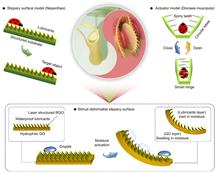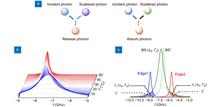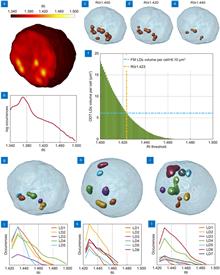 View fulltext
View fulltext
Carnivorous plants, for instance, Dionaea muscipula and Nepenthes pitcher plant, inspired the innovation of advanced stimuli-responsive actuators and lubricant-infused slippery surfaces, respectively. However, hybrid bionic devices that combine the active and passive prey trapping capabilities of the two kinds of carnivorous plants remain a challenge. Herein, we report a moisture responsive shape-morphing slippery surface that enables both moisture responsive shape-morphing and oil-lubricated water repellency for simultaneous active- and passive-droplet manipulation. The moisture deformable slippery surface is prepared by creating biomimetic microstructures on graphene oxide (GO) membrane via femtosecond laser direct writing and subsequent lubricating with a thin layer of oil on the laser structured reduced GO (LRGO) surface. The integration of a lubricant-infused slippery surface with an LRGO/GO bilayer actuator endows the actuator with droplet sliding ability and promotes the moisture deformation performance due to oil-enhanced water repellency of the inert layer (LRGO). Based on the shape-morphing slippery surface, we prepared a series of proof-of-concept actuators, including a moisture-response Dionaea muscipula actuator, a smart frog tongue, and a smart flower, demonstrating their versatility for active/passive trapping, droplet manipulation, and sensing.Carnivorous plants, for instance, Dionaea muscipula and Nepenthes pitcher plant, inspired the innovation of advanced stimuli-responsive actuators and lubricant-infused slippery surfaces, respectively. However, hybrid bionic devices that combine the active and passive prey trapping capabilities of the two kinds of carnivorous plants remain a challenge. Herein, we report a moisture responsive shape-morphing slippery surface that enables both moisture responsive shape-morphing and oil-lubricated water repellency for simultaneous active- and passive-droplet manipulation. The moisture deformable slippery surface is prepared by creating biomimetic microstructures on graphene oxide (GO) membrane via femtosecond laser direct writing and subsequent lubricating with a thin layer of oil on the laser structured reduced GO (LRGO) surface. The integration of a lubricant-infused slippery surface with an LRGO/GO bilayer actuator endows the actuator with droplet sliding ability and promotes the moisture deformation performance due to oil-enhanced water repellency of the inert layer (LRGO). Based on the shape-morphing slippery surface, we prepared a series of proof-of-concept actuators, including a moisture-response Dionaea muscipula actuator, a smart frog tongue, and a smart flower, demonstrating their versatility for active/passive trapping, droplet manipulation, and sensing.
Long-term optical data storage (ODS) technology is essential to break the bottleneck of high energy consumption for information storage in the current era of big data. Here, ODS with an ultralong lifetime of 2×107 years is attained with single ultrafast laser pulse induced reduction of Eu3+ ions and tailoring of optical properties inside the Eu-doped aluminosilicate glasses. We demonstrate that the induced local modifications in the glass can stand against the temperature of up to 970 K and strong ultraviolet light irradiation with the power density of 100 kW/cm2. Furthermore, the active ions of Eu2+ exhibit strong and broadband emission with the full width at half maximum reaching 190 nm, and the photoluminescence (PL) is flexibly tunable in the whole visible region by regulating the alkaline earth metal ions in the glasses. The developed technology and materials will be of great significance in photonic applications such as long-term ODS.Long-term optical data storage (ODS) technology is essential to break the bottleneck of high energy consumption for information storage in the current era of big data. Here, ODS with an ultralong lifetime of 2×107 years is attained with single ultrafast laser pulse induced reduction of Eu3+ ions and tailoring of optical properties inside the Eu-doped aluminosilicate glasses. We demonstrate that the induced local modifications in the glass can stand against the temperature of up to 970 K and strong ultraviolet light irradiation with the power density of 100 kW/cm2. Furthermore, the active ions of Eu2+ exhibit strong and broadband emission with the full width at half maximum reaching 190 nm, and the photoluminescence (PL) is flexibly tunable in the whole visible region by regulating the alkaline earth metal ions in the glasses. The developed technology and materials will be of great significance in photonic applications such as long-term ODS.
The Brillouin scattering spectrum has been used to investigate the properties of a liquid medium. Here, we propose an improved method based on the double-edge technique to obtain the Brillouin spectrum of a liquid. We calculated the transmission ratios and deduced the Brillouin shift and linewidth to construct the Brillouin spectrum by extracting the Brillouin edge signal through filtered double-edge data. We built a detection system to test the performance of this method and measured the Brillouin spectrum for distilled water at different temperatures and compared it with the theoretical prediction. The observed difference between the experimental and theoretical values for Brillouin shift and linewidth is less than 4.3 MHz and 3.2 MHz, respectively. Moreover, based on the double-edge technique, the accuracy of the extracted temperatures and salinity is approximately 0.1 °C and 0.5%, respectively, indicating significant potential for application in water detection and oceanography.The Brillouin scattering spectrum has been used to investigate the properties of a liquid medium. Here, we propose an improved method based on the double-edge technique to obtain the Brillouin spectrum of a liquid. We calculated the transmission ratios and deduced the Brillouin shift and linewidth to construct the Brillouin spectrum by extracting the Brillouin edge signal through filtered double-edge data. We built a detection system to test the performance of this method and measured the Brillouin spectrum for distilled water at different temperatures and compared it with the theoretical prediction. The observed difference between the experimental and theoretical values for Brillouin shift and linewidth is less than 4.3 MHz and 3.2 MHz, respectively. Moreover, based on the double-edge technique, the accuracy of the extracted temperatures and salinity is approximately 0.1 °C and 0.5%, respectively, indicating significant potential for application in water detection and oceanography.
The most recent discoveries in the biochemical field are highlighting the increasingly important role of lipid droplets (LDs) in several regulatory mechanisms in living cells. LDs are dynamic organelles and therefore their complete characterization in terms of number, size, spatial positioning and relative distribution in the cell volume can shed light on the roles played by LDs. Until now, fluorescence microscopy and transmission electron microscopy are assessed as the gold standard methods for identifying LDs due to their high sensitivity and specificity. However, such methods generally only provide 2D assays and partial measurements. Furthermore, both can be destructive and with low productivity, thus limiting analysis of large cell numbers in a sample. Here we demonstrate for the first time the capability of 3D visualization and the full LD characterization in high-throughput with a tomographic phase-contrast flow-cytometer, by using ovarian cancer cells and monocyte cell lines as models. A strategy for retrieving significant parameters on spatial correlations and LD 3D positioning inside each cell volume is reported. The information gathered by this new method could allow more in depth understanding and lead to new discoveries on how LDs are correlated to cellular functions.The most recent discoveries in the biochemical field are highlighting the increasingly important role of lipid droplets (LDs) in several regulatory mechanisms in living cells. LDs are dynamic organelles and therefore their complete characterization in terms of number, size, spatial positioning and relative distribution in the cell volume can shed light on the roles played by LDs. Until now, fluorescence microscopy and transmission electron microscopy are assessed as the gold standard methods for identifying LDs due to their high sensitivity and specificity. However, such methods generally only provide 2D assays and partial measurements. Furthermore, both can be destructive and with low productivity, thus limiting analysis of large cell numbers in a sample. Here we demonstrate for the first time the capability of 3D visualization and the full LD characterization in high-throughput with a tomographic phase-contrast flow-cytometer, by using ovarian cancer cells and monocyte cell lines as models. A strategy for retrieving significant parameters on spatial correlations and LD 3D positioning inside each cell volume is reported. The information gathered by this new method could allow more in depth understanding and lead to new discoveries on how LDs are correlated to cellular functions.












